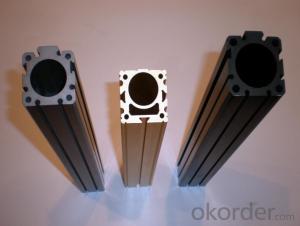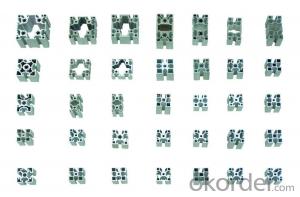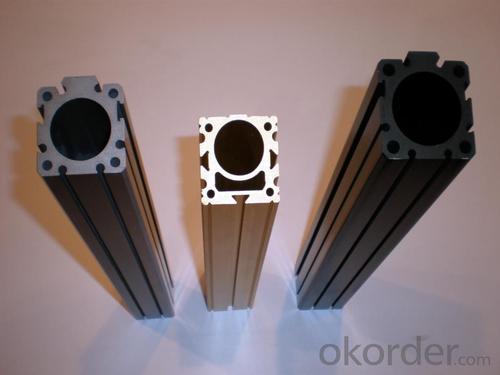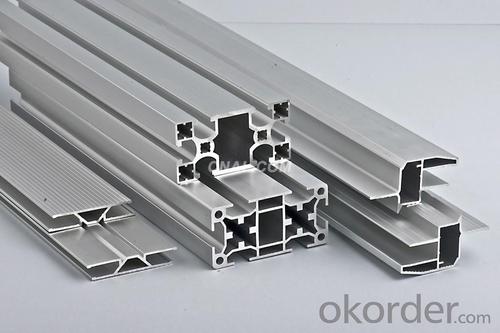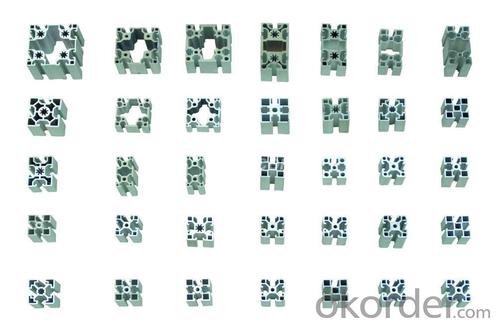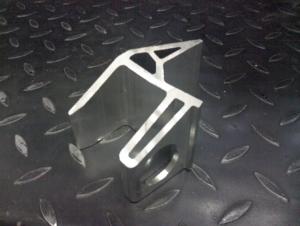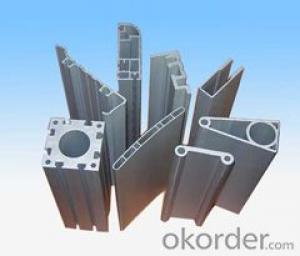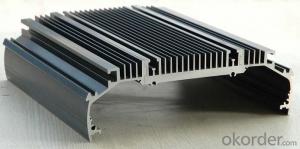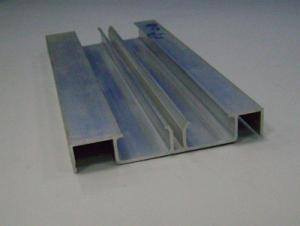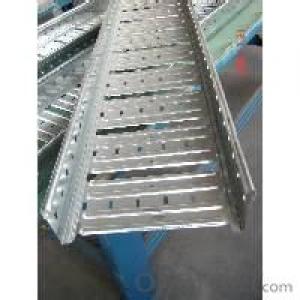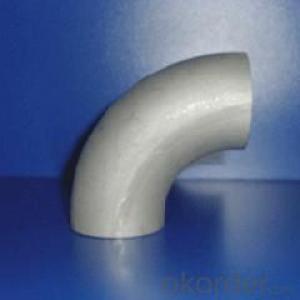Aluminum Extrusion Profiles Singapore - Aluminum Section/Aluminum Window and Door Profile
- Loading Port:
- China Main Port
- Payment Terms:
- TT OR LC
- Min Order Qty:
- -
- Supply Capability:
- -
OKorder Service Pledge
OKorder Financial Service
You Might Also Like
Aluminium is a relatively soft,durable, lightweight, ductile and malleablemetal with appearance ranging from silvery to dull gray,depending on the surface roughness. It is nonmagnetic and does not easilyignite. A fresh film of aluminium serves as a good reflector (approximately92%) of visible light and an excellent reflector (as much as98%) of medium and far infrared radiation. The yield strength of pure aluminium is 7–11 MPa,while aluminium alloys have yield strengths ranging from200 MPa to 600 MPa. Aluminium has about one-third the density and stiffnessof steel. It iseasily machined,cast, drawn and extruded.
Aluminum Profile
Material | Alloy 6063,6061,6005or according to customer’s choice |
Temper | T3, T4, T5, T6 |
Surface | Anodize, electrophoresis, powder coating, PVDF coating, wood grain painting, matted, etc. |
Length | Coating 6.5 meters, Anodizing 6.5 meters, Mill finish 5 meters |
Application | Industrial, electrical equipment(TV set, air conditioner, refrigerator, computer), decoration,construction, transportation |
Custom Made | We can package following with customer's request. |
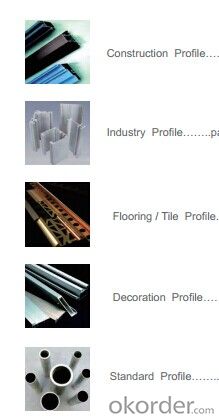
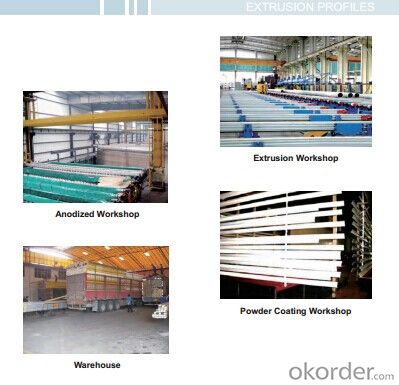
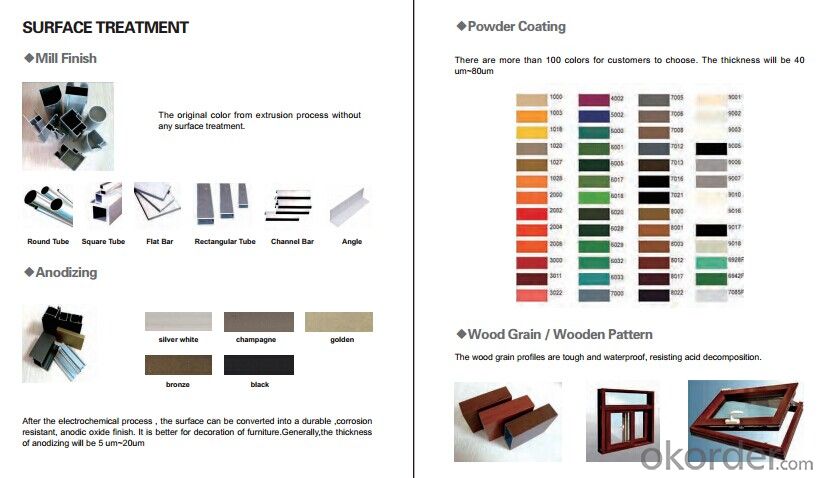
- Q: Can aluminum profiles cross Luo? Why is the appearance of an aluminum profile component of a Japanese original machine extremely close to that of Luo Luo? Why? Why?
- The company since its establishment, relying on preferential policies, the local government to adhere to the people-oriented, development of the concept of Societe Generale, seek survival by quality, rely on the brand to expand the market, seize the opportunity, innovation, build a pragmatic and efficient, solidarity of the modern enterprise team.Luoyang is located in the Central Plains, is a famous industrial base, its energy and resource advantages, a strong industrial base, research institutes everywhere, has created favorable conditions for the development of the aluminum industry of new and high technology, coupled with the current domestic and foreign aluminum demand is far greater than the output of this special factors, provides a good opportunity for the more the project, the project prospects for a broader market.
- Q: This question asks for a comparison of the benefits and drawbacks of utilizing aluminum profiles in the construction of roofs.
- <p>Aluminum profiles in roofing offer several advantages, including their lightweight nature which reduces structural load, high corrosion resistance making them suitable for various climates, and ease of installation which can lower labor costs. They also have a long lifespan and can be recycled, contributing to sustainability. However, there are disadvantages such as higher initial costs compared to traditional materials, potential for dents or damage from impacts, and the need for regular maintenance to preserve their finish and prevent fading. Additionally, aluminum can be noisy during rain or hail, and it may not be as thermally efficient as some other roofing materials, potentially requiring additional insulation.</p>
- Q: This question asks for a comparison of aluminum profiles with other materials regarding their weight and strength characteristics.
- <p>Aluminum profiles are known for their high strength-to-weight ratio, making them lighter than many other materials while maintaining significant strength. Compared to steel, aluminum is approximately one-third the weight but offers comparable strength, especially in alloy forms. When compared to plastics, aluminum profiles have greater rigidity and durability. They also resist corrosion and are more heat resistant than many plastics. However, aluminum profiles are generally more expensive than plastics and some steels. In summary, aluminum profiles offer a balance of low weight and high strength, making them suitable for applications where weight savings and structural integrity are crucial.</p>
- Q: Are aluminum profiles suitable for use in automotive body structures?
- Automotive body structures can indeed utilize aluminum profiles effectively. Aluminum, being a lightweight and durable material, offers numerous advantages in the automotive industry. Its high strength-to-weight ratio makes it an ideal option for constructing body frames, panels, and other structural components. The utilization of aluminum profiles in automotive body structures brings several benefits. Firstly, it enhances fuel efficiency by reducing the overall weight of the vehicle. This, in turn, leads to improved acceleration and handling. Moreover, aluminum exhibits exceptional corrosion resistance, allowing it to withstand harsh environmental conditions and increase the lifespan of the vehicle. Additionally, aluminum profiles can be easily shaped and molded into intricate designs, providing greater flexibility in automotive body structures. This versatility enables manufacturers to create more visually appealing and aerodynamic vehicles. While aluminum profiles offer a multitude of advantages, there are also some considerations to bear in mind. Aluminum can be more costly than traditional steel, potentially impacting the overall cost of the vehicle. Furthermore, the repair and maintenance of aluminum structures may require specialized equipment and expertise. Nevertheless, these factors are outweighed by the benefits aluminum profiles bring to the automotive industry. In conclusion, aluminum profiles are indeed suitable for use in automotive body structures due to their lightweight, durable, corrosion-resistant properties, and design flexibility. These characteristics make them an excellent choice for constructing modern vehicles.
- Q: This question asks if aluminum profiles can be utilized for constructing exterior walls or facades.
- <p>Yes, aluminum profiles can be used for exterior walls or facades. They are known for their durability, low maintenance, and resistance to weather conditions. Aluminum is lightweight, strong, and can be easily shaped into various designs, making it an ideal material for modern architecture. It also offers excellent thermal performance and can be combined with insulation to enhance energy efficiency. Additionally, aluminum profiles can be powder-coated or anodized to provide a protective finish and a wide range of color options, enhancing the aesthetic appeal of the building facade.</p>
- Q: The subject is aluminum bearing in what u ~ on both sides of the track?? How can the track be fitted into this slot? Both sides secure 50Mechanical expert answers!The subject is aluminum bearing in what u ~ on both sides of the track?? How can the track be fitted into this slot? How can the seat of fixed motor on both sides be connected with the section bar?
- The bearings are mounted on type U rails, which are specially made on the market. The rails and profiles are integral, not mounted.
- Q: This question asks for guidance on ensuring a safe and efficient installation process for aluminum profiles.
- <p>To ensure a safe and efficient installation process for aluminum profiles, follow these steps: Use appropriate safety gear such as gloves and goggles. Ensure the profiles are of high quality and fit for purpose. Plan the installation carefully, marking out the positions accurately. Use the correct tools for cutting and drilling, and ensure they are sharp and well-maintained. Install the profiles in a clean, dry environment to prevent damage. Follow the manufacturer's guidelines for assembly and use the correct fasteners. Regularly inspect the installation for any signs of wear or damage. By adhering to these practices, you can ensure a safe and efficient installation process.</p>
- Q: Can aluminum profiles be used for electrical bus ducts?
- Yes, aluminum profiles can be used for electrical bus ducts. Aluminum is a suitable material for bus ducts as it is lightweight, corrosion-resistant, and has good electrical conductivity. Additionally, aluminum profiles can be easily fabricated and installed, making them a popular choice for electrical bus ducts in various industries.
- Q: Can aluminum profiles be used in the automotive industry?
- Yes, aluminum profiles can be used in the automotive industry. Aluminum is a lightweight and durable material that is commonly used in the manufacturing of car frames, body panels, and other components. Its high strength-to-weight ratio and corrosion resistance make it a preferred choice for improving fuel efficiency and reducing vehicle weight. Additionally, aluminum profiles offer design flexibility, allowing for the creation of complex shapes and structures, making them suitable for various automotive applications.
- Q: Are aluminum profiles suitable for use in exterior wall systems?
- <p>Yes, aluminum profiles are commonly used for exterior wall systems due to their durability, low maintenance, and resistance to corrosion and weathering. They offer a lightweight and strong alternative to traditional materials, and can be designed to provide thermal insulation and aesthetic appeal. Their versatility allows for various configurations and customizations, making them suitable for a wide range of architectural styles and requirements.</p>
Send your message to us
Aluminum Extrusion Profiles Singapore - Aluminum Section/Aluminum Window and Door Profile
- Loading Port:
- China Main Port
- Payment Terms:
- TT OR LC
- Min Order Qty:
- -
- Supply Capability:
- -
OKorder Service Pledge
OKorder Financial Service
Similar products
Hot products
Hot Searches
Related keywords
